|
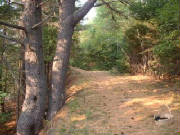
|
| Saltsprings Provincial Park. |
Clothing should be of a sensible nature with stout boots being an necessity.Also, and especially
in the Fall, a brightly coloured jacket or hat will be necessary to alert hunters who may also be around pursuing their pastime.
A walking cane is also useful for probing undergrowth and supporting oneself on uneven ground.In unfamiliar surroundings a
compass or GPS would also be a wise item to carry. A good knife is also necessary for digging out the whole fungus since
one of the identifying characteristics of a deadly Amanita is the cup(Volva) at the base of the mushroom. A good basket is
essential.I would recommend one made of wicker if it is available to you. After picking, some mushrooms deteriorate very quickly.It
is also wise to segregate the mushrooms within the basket.This can be done by utilising paper bags, wax paper or greaseproof
paper to wrap your specimens in. Clearly visible,above and at left, is my favoured wicker basket that allows the gathered
mushrooms to "breathe".This kind of container is preferable to enclosed containers such as plastic bags etc. Rounding out
the must haves is a 10X hand lense.
And if you are anything like me Don't forget your camera !
Seek out your local Naturalist Society.
There may be a member of the local society who has the necessary knowledge
to lead a field trip.
Visit your local bookstore and explore the section devoted to "Nature", check out which mushroom
field guides are available to you. If I could only recommend one Field Guide it would be "The Audubon Society Field
Guide to North American Mushrooms". It was the first book that I bought myself some 25 years ago and it is still a constant
companion when I venture in to the woods.
Studying Mushrooms.
Hopefully, when you find mushrooms they will be in different stages of growth. It is preferable
to pick mushrooms that are in several stages of growth since then you will have a good representation of their appearance
from immature to maturity.. The difference in appearance of some mushrooms in different stages of their development is
sometimes very surprising.
For the budding mycologist the identification of fungi is often a frustrating task. One of
the most popular ways of attempting identification is to thumb through a Field Guide in the hope that you will find a photograph
of your "find". This can,coupled with the text's description sometimes result in a successful identification. Unfortunately
there is no book that covers all the species that you may encounter in the woods of Nova Scotia,or any other place for that
matter. I am always on the look out for books on mushrooms and I have quite a collection now,but I don't think that I will
ever have enough. In a lot of cases identifying to Genus is quite an accomplishment and should not discourage you from pursuing
your hobby.
Pictured below are mature and immature Honey Mushrooms, Armillariella
mellea.
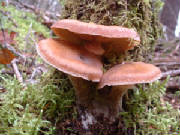
|
| MATURE. The Honey Mushroom,Armillariella mellea |
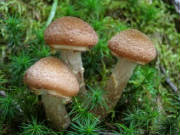
|
| IMMATURE. The Honey Mushroom,Armillariella mellea. |
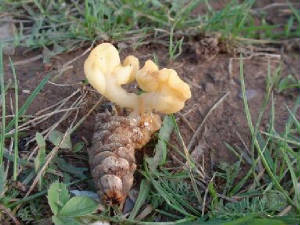
|
| Fairy Fan, Spathularia flavida. |
Therefore to begin the identification process we must follow a logical sequence.The
specimens you gather should be systematically examined and notes taken as you progress. It is also particularly important
to take note of the environment where you made your find. As well as trying to "fit" your find in to a genus and ultimately
species it must also "fit" in to the environment that you found it in. In other words, if you gather only facts then
ALL the facts must fit before you can say with any certainty that you have identified your specimen correctly. For instance,
is the fungus growing directly out of the ground,is it growing on submerged decaying wood, or the trunk of a tree or
on a pine cone as the example to the left shows. Is the tree living,dying or dead? What trees are in the immediate vicinity,
since your specimen may have formed an mycorrhizal association with a host tree. Are you in the woods or in a grassy
area,a meadow a sandy area(we are almost surrounded by the sea) or some other habitat? All these
questions can aid in identifying your specimen.
The next step is to describe the fungus itself. You may wish to start with
the cap and work your way down.
Cap; colour,size ,shape,is the surface dry,slimy,moist. Does
the surface of the cap have hairs,warts,scales,striations or is it perhaps zoned(bands of varying colours of different
diameters).
Gills;Colour(not always an indication of spore
print colour) are the gills free from the stem, are they notched(almost reaching the stem but not quite) this is known as
adnexed. Are the gills attached,known as adnate, or do they perhaps run down the stem,decurrent. Are the gills crowded,close
or distant.
Ring(Annulus);Is a ring present or absent.Single
or double. Is the ring superior or inferior(flaring at the bottom, or the top of the ring).
Stalk(Stipe); Size,shape,hollow,stuffed,single
or joined with others (cespitose), are there hairs,warts,scabers.
Flesh;Colour,is the texture tough,firm or soft.Does
the flesh bruise(change colour) when touched or cut and if so what colour? After cutting does it exude a milky fluid(latex) indicative
of the genus Lactarius. Does the latex itself change colour.
Odour; Is the odour strong,mild ,nondescript
or is it reminiscent of something familiar?
Taste; Disagreeable, mild or pleasant?. DO
NOT under any circumstance swallow any part of a mushroom that you decide to taste. If you do decide to taste it,
break off a tiny piece and always spit it out afterwards.
Host; Is the fungus on the ground,on wood,needles,duff
etc. Is it under coniferous or deciduous trees or a mixture of both.Is it growing in a grassy area,meadow,in sandy
soil or on dung etc.
Below are pictured mature specimens of Slimy Gomphidius,
Gomphidius glutinosus and the spore print it deposited.
One of the most important things to ascertain when studying mushrooms is the colour of the
the spore deposit (spore print). This can be done by cutting off the stalk at the point where it meets the cap and laying
the mushroom gill (or pore) side down on a sheet of white paper in your basket. By the time you arrive home it is very possible
that the mushroom may have "dropped" it's spores on to your paper.Sometimes it is necessary to leave the mushroom overnight
to collect a good deposit.
The spore print of The Slimy Gomphidius, Gomphidius glutinosus is
smoky grey to blackish. It's found amongst conifers,especially spruce.
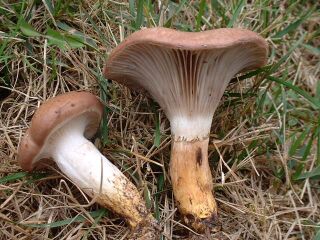
|
| Slimy Gomphidius, Gomphidius gluutinosus. |
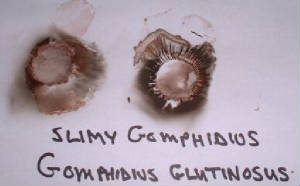
|
| Spore print of Slimy Gomphidius,Gomphidius glutinosus. |
|




